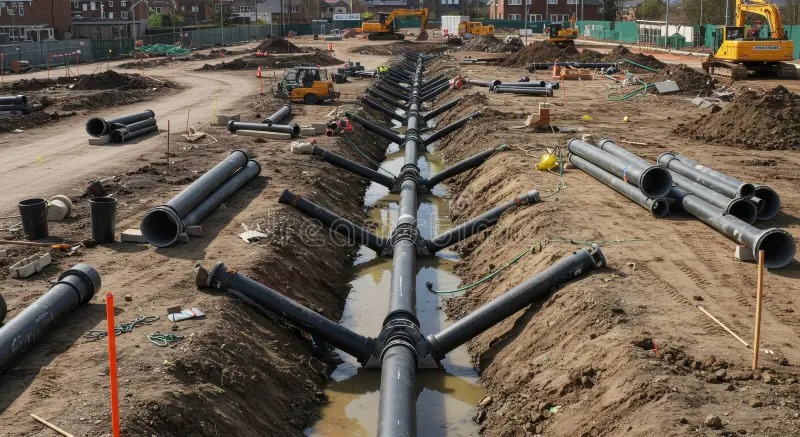Modern cities are expanding rapidly, bringing with them a growing concern — how to manage stormwater effectively. Urbanization has replaced natural landscapes with concrete, asphalt, and rooftops that prevent water absorption. As a result, rainfall often leads to excessive runoff, flooding, and pollution. To address these issues, engineers and planners are increasingly turning to Sustainable Urban Drainage Systems (SUDS) — an innovative, environmentally friendly approach to water management.
What Are Sustainable Urban Drainage Systems (SUDS)?
Sustainable Urban Drainage Systems (SUDS) are designed to mimic natural water processes, managing rainfall close to where it lands rather than sending it directly to sewers. Instead of focusing solely on fast drainage, SUDS slow down, store, and treat runoff before it is released into the environment.
These systems replicate how nature deals with rain — through infiltration, evaporation, and filtration — helping reduce the risks of flooding and improving water quality. Unlike conventional drainage networks, SUDS bring both functional and environmental benefits to urban areas.
Core Principles of SUDS
SUDS are based on four key principles that ensure both sustainability and efficiency:
- Manage Water at Its Source:
Instead of moving stormwater away quickly, SUDS manage it locally where it falls, reducing flood risks downstream. - Improve Water Quality:
By filtering water through natural materials like soil and vegetation, SUDS remove sediments, oils, and pollutants. - Enhance Biodiversity and Amenity:
Green spaces created as part of SUDS — such as swales, ponds, and wetlands — support wildlife and make urban areas more attractive. - Ensure Long-Term Sustainability:
These systems use natural processes that require minimal energy and maintenance compared to conventional drainage.
Main Components of a SUDS System
A successful SUDS design includes a combination of engineered and natural features. Each component works together to manage stormwater sustainably:
- Permeable Pavements:
Allow rainwater to soak through the surface and into the ground, reducing surface runoff. - Swales:
Shallow, vegetated channels that transport and filter runoff naturally while enhancing the visual appeal of urban landscapes. - Green Roofs:
Roofs covered with vegetation that absorb rainfall, provide insulation, and reduce the urban heat island effect. - Infiltration Basins:
Shallow depressions that collect water temporarily and allow it to seep into the ground. - Retention and Detention Ponds:
These ponds collect and store excess rainwater, releasing it gradually to prevent flooding and encourage habitat creation. - Constructed Wetlands:
Artificial wetlands that filter pollutants and provide ecological and recreational value.
Environmental Benefits of SUDS
Implementing SUDS brings numerous environmental benefits, making it a cornerstone of sustainable urban development:
- Flood Prevention:
By controlling water at its source, SUDS reduce the amount of runoff entering drainage systems, lowering the risk of floods. - Water Quality Improvement:
Natural filtration removes harmful pollutants before they enter rivers, lakes, or groundwater systems. - Groundwater Recharge:
Allowing water to soak into the soil helps replenish underground aquifers, maintaining natural water cycles. - Habitat Creation:
Ponds, wetlands, and vegetated swales support biodiversity by providing habitats for birds, insects, and aquatic life. - Climate Adaptation:
SUDS contribute to urban cooling, reduce pollution, and increase resilience against extreme weather events caused by climate change.
Social and Economic Benefits
Beyond environmental gains, SUDS offer strong social and economic advantages:
- Cost-Effective Solutions:
They are often cheaper to build and maintain than traditional underground drainage systems. Natural infiltration reduces the need for large, expensive pipes. - Improved Urban Spaces:
Green infrastructure enhances city aesthetics, creating pleasant and healthier living environments. - Community Well-being:
Access to greener, cleaner surroundings improves mental health, air quality, and social interaction. - Increased Property Value:
Developments with sustainable features like SUDS are often more attractive to buyers and investors.
Incorporating SUDS in residential and commercial projects demonstrates a commitment to long-term sustainability and community development.
How SUDS Are Implemented in Modern Cities
Implementation of Sustainable Urban Drainage Systems involves several stages, from planning to maintenance. The process typically includes:
- Site Assessment:
Engineers study topography, soil type, rainfall patterns, and existing drainage infrastructure to design suitable SUDS solutions. - Design Integration:
SUDS are incorporated into site layouts early in the planning process, combining engineering efficiency with landscape design. - Construction:
The system is built using a mix of natural materials and engineering techniques that promote infiltration and retention. - Monitoring and Maintenance:
Although SUDS are low-maintenance, periodic checks ensure vegetation remains healthy and filtration systems continue to function effectively.
Real-World Examples of SUDS
Many countries around the world have successfully adopted SUDS as part of their urban infrastructure:
- United Kingdom:
Local councils require SUDS in most new developments to reduce flooding and improve water quality. - Singapore:
The “Active, Beautiful, Clean Waters” program integrates green infrastructure and water-sensitive urban design across the city. - Australia:
SUDS, often called “Water Sensitive Urban Design,” are used in residential communities to manage stormwater naturally.
These examples show how adaptable and scalable SUDS can be — from large cities to small towns — providing both environmental and social returns.
Challenges in Implementing SUDS
While SUDS are beneficial, they do come with certain challenges:
- Limited Space in Urban Areas:
Densely built environments may have restricted land for open drainage features. - Maintenance Awareness:
Some stakeholders may underestimate the need for regular inspections, leading to reduced performance over time. - Public Understanding:
Lack of awareness can sometimes lead to poor system protection or misuse by local residents.
Overcoming these challenges requires coordinated planning, public education, and collaboration between engineers, planners, and municipalities.
Conclusion
Sustainable Urban Drainage Systems (SUDS) represent a shift in how we view urban water management — from a problem to an opportunity. By working with nature rather than against it, SUDS help cities manage stormwater more intelligently, reduce flooding, and create greener, more livable spaces.
As climate change intensifies and cities continue to expand, adopting SUDS will become essential for building resilience and ensuring long-term environmental health. With thoughtful design and proper implementation, these systems can transform urban landscapes into sustainable ecosystems that benefit both people and the planet.

